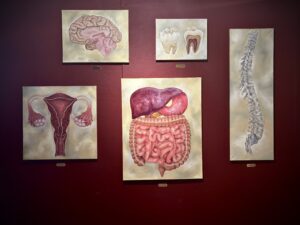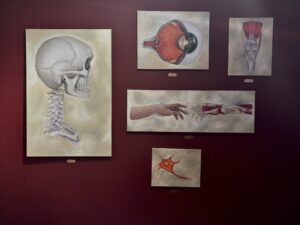Dissecting Beauty


Morgan Granzow, Penny W. Stamps School of Art & Design
Consultations with: Audrey Bell, Medical Illustrator in Detroit; Dr. Melissa Gross, Arthur F Thurnau Professor, Associate Professor of Movement Science and Associate Professor of Art and Design; Andrew Thompson, Lecturer II, Stamps; and Hayden Richer, Ceramics Studio Coordinator at Stamps
Dissecting Beauty is an interdisciplinary project about the interlocked relationship between science and art, exploring the connection between anatomical science and the art of painting and sculpture. Throughout my own research, I’ve drawn connections between the science and art fields, believing that one truly cannot exist without the other. I intend to highlight the importance of medical/scientific illustration by creating a series of hyper realistic paintings of internal organs, bones, and anatomical depictions posed in “artistic” compositions to allow the average viewer, who may have otherwise found internal anatomy “disturbing,” to view the internal body as a subject of beauty and intricacy instead.
Dissecting Beauty also touches on the beauty of the natural world and societal perceptions of beauty. This project has inspired the questioning of how these structures interact underneath our skin and how they build and dismantle who we are as individuals. Additionally, I will sculpt a life-sized sculpture of my body with the stomach/thoracic region sliced open to reveal the internal anatomy. Inspired by the Anatomical Venus and the art history of anatomists, I want viewers to share my perspective on anatomy as a form of art.
This project will be carefully carried out over the course of the next few months to create an immersive and engaging exhibition that encourages the audience to question their own perceptions of how science and art are intermingled.
The timeline for this project is written out intricately on a week-by-week schedule from now until mid-March, with the general timeline as such: finishing the first 2-3 paintings, ordering all materials, testing the sculptural elements (November-December), completing 3-4 more paintings and sculpt body (January), paint and wax the plaster body, sculpt the internal organs, and complete 4-5 more paintings (February), paint/wax the organs and finalize the rest of the paintings (March), and finally the installation completed by April.
I believe that I have the skills to complete this project of my knowledge in both anatomy and art and my desire to connect them in order to pursue medical illustration upon graduation. In the process of creation, I am tasked with studying the anatomy itself to better understand the subject I am depicting. To do this, I use sources of 3D printed bones, textbooks from anatomists in art history, and online research.
Over my time at Stamps, I have focused my practice to scientific illustration and studying the human body. This has allowed me to become precise with my techniques and learn how to accurately portray the scientific world. Furthermore, I have been a studio assistant at the ceramics studio, providing me with education, experiences, and resources that will continue to aid me. Finally, this project is incredibly important to me because it will be my last project as a student at Stamps, in which I hope to make it my best. I know that I have the work ethic and will to create this work and look forward to being immersed in this project.
Anatomical intricacy can be something separate from the physical trauma that can be associated when confronted with the internal body. The structures beneath our skin create and dismantle who we are as individuals. Throughout history to our current day, women have been subject to unjust standards that infect our physical and emotional wellbeing.
As a result of a patriarchal society, women’s healthcare is still decades behind men’s. Similarly to the lives of thousands of women, I’ve only ever viewed my body with disgust, constraining
myself to the harsh realities of what it means to be a woman.
Through the lens of body dysmorphia, I investigated my own perception of beauty in a life-sized self portrait in the vein of Clemente Susini’s Anatomical Venus. The art of anatomy embraces
the extraordinary beauty of how those structures inform our identities.
Evidently, my work draws attention to the necessity of medical illustration in visualizing the unknown and accentuates the intertwined relationship between science and art, proposing that
one cannot exist without the other. I ask viewers to dissect the work in front of you, to reevaluate your own perception of beauty, and to discover the anatomy of your identity.
My work is on exhibition from April 21 – May 3 at the Stamps Perspective{s} exhibition.
My project was more possible as a result of the ArtsEngine MicroGrant, and I was more ambitious and successful as a result! Due to the size and material, I was able to explore many
more possibilities and experiment in order to create the best project I could.
View Morgan’s Dissecting Beauty page to see all photos and learn more.
